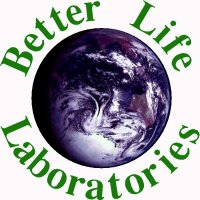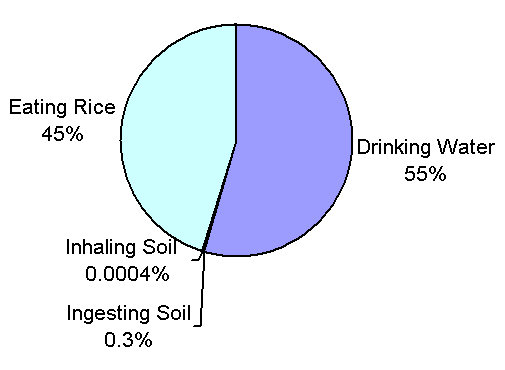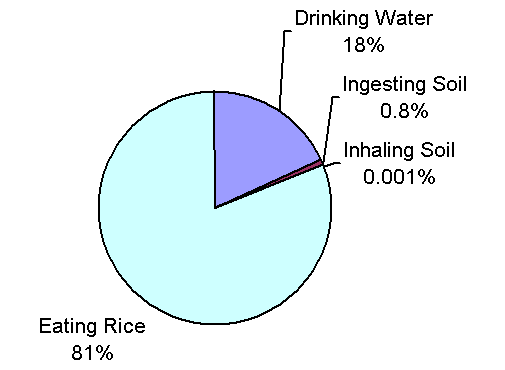|
Richard Ortega, Ph.D. / Université de Bordeaux 1 Seth H. Frisbie, Ph.D. / Better Life Laboratories, Inc. Dorothea Alber, Ph.D. / Hahn-Meitner-Institut Berlin Guillaume Devès / Université de Bordeaux 1 Brigitte Stanik / Hahn-Meitner-Institut Berlin Donald M. Maynard, P.E. / The Johnson Company, Inc. Bibudhendra Sarkar, Ph.D. / University of Toronto and The Hospital for Sick Children Presented at the Nineteenth Annual Conference on Contaminated Soils, Sediments and Water, University of Massachusetts, Amherst, MA, 2003. |
 |
This is the first assessment of exposure to arsenic (As), barium (Ba), cesium (Cs), chromium (Cr), cobalt (Co), iron (Fe), manganese (Mn), rubidium (Rb), selenium (Se), and zinc (Zn) from Bangladesh’s drinking water, rice, and soil.
The people of Bangladesh used to rely on surface water for drinking, which was often contaminated with bacteria that caused diarrhea, cholera, typhoid, and other life-threatening diseases. To reduce the incidences of these diseases, approximately 8,000,0000 to 12,000,000 tubewells were installed in Bangladesh since independence in 1971 (1). Today 97% of Bangladesh’s 137,000,000 people drink tubewell water (2,3). This recent transition from surface water to tubewell water has significantly reduced deaths from water-borne pathogens; however, tens of millions of Bangladeshis are drinking water with unsafe concentrations of As or Mn.
Approximately 49% of Bangladesh’s area contains tubewell water with As concentrations greater than the World Health Organization (WHO) 10 µg/L health-based drinking water guideline (4). Similarly, approximately 50% of Bangladesh’s area contains tubewell water with Mn concentrations greater than the WHO 500 µg/L health-based drinking water guideline (4).
There is sufficient evidence from human epidemiological studies linking increased mortality from skin, liver, colon, kidney, bladder, and lung cancers to drinking As-contaminated water (5,6). In addition, Mn is a known mutagen (7). The accumulation of Mn may cause hepatic encephalopathy (8). The chronic ingestion of Mn in drinking water is associated with neurological damage (9). The 500 µg/L WHO drinking water guideline for Mn was calculated using human exposures in Japan and Greece, and studies of various laboratory animals where neurotoxic and other effects were observed (10).
Drinking water, rice, and soil samples were collected from 8 randomly selected households in Bangladesh during December 20, 1998 to January 18, 1999. All of these samples were analyzed for As, Ba, Cs, Cr, Co, Fe, Mn, Rb, Se, and Zn. These analyses were used to estimate the level of exposure to these elements in these households.
The As, Ba, Cs, Cr, Co, Mn, Rb, Se, and Zn in drinking water samples were analyzed by Inductively Coupled Plasma Mass Spectrometry (ICP/MS) with a Fisons PlasmaQuad PQ2+ spectrometer. These ICP/MS analyses were done at the Laboratoire Pierre Süe, Centre National de la Recherche Scientifique in Gif-sur-Yvette, France. Multi-element standard solutions were prepared from SPEX CertiPrep, Inc. (SPEX) certified solutions. Mono-elemental SPEX certified solutions of Be, In, and Re were used as internal standards. All samples were analyzed by ICP/MS twice. First undiluted samples were analyzed for trace elements. Then samples were diluted 10 times using ultrapure water and acidified to pH 2 with Prolabo Normatom I grade nitric acid for the determination of major elements (11,12).
The Fe in these drinking water samples was analyzed by Particle Induced X-ray Emission (PIXE) Rutherford Backscattering Spectrometry (RBS) using a 4 MV Van de Graaff accelerator and nuclear microprobe beamline (13,14). This analysis was done at the Université de Bordeaux 1, Laboratoire de Chimie Nucléaire Analytique et Bioenvironnementale in Gradignan, France. Multi-element standard solutions were prepared from Sigma certified solutions. Yttrium at a final concentration of 50 mg/L was used as an internal standard.
The rice and soil samples were analyzed by Instrumental Neutron Activation Analysis. These analyses were done at the BERII research reactor in Berlin, Germany. These solid samples were homogenized into a fine powder with a mortar and pestle. After which, the stable isotopes were activated to radioactive isotopes with thermal neutrons. Finally, the radioactive decay was measured by gamma spectrometry using a Ge solid-state detector.
This is a preliminary assessment of human exposure to As, Ba, Cs, Cr, Co, Fe, Mn, Rb, Se, and Zn from Bangladesh’s drinking water, rice, and soil. The results for As and Mn are emphasized because these elements are known to be above WHO health-based drinking water guidelines in large areas of Bangladesh (4). The purpose of this study is to identify the requirements for a more detailed exposure assessment in the near future.
The estimated exposures to As, Ba, Cs, Cr, Co, Fe, Mn, Rb, Se, and Zn from Bangladesh’s drinking water, rice, and soil are shown in Table 1. The estimated exposures to As and Mn are also depicted graphically in Figures 1 and 2, respectively. These estimates assume that 2 liters of drinking water are ingested per person per day (10), 149.7 kg of rice are ingested per person per year (15), 2.3 L of water are used to cook 1 kg of rice (16), 60% of each element in this cooking water is absorbed by this rice (16), 100 mg of soil are ingested per person per day (17), and a 62 kg person inhales 0.0026 mg of soil per kg of body weight each day (17). Subsequent exposure assessments must use Bangladesh-specific ingestion rates for drinking water, all foods, and soil and Bangladesh-specific inhalation rates for soil.
 |
 |
| Element | Dietary Reference Intake (µg/day) |
Exposure from Water, Rice, and Soil (µg/day) |
Exposure from Drinking Water (%) |
Exposure from Eating Rice (%) |
Exposure from Ingesting Soil (%) |
Exposure from Inhaling Soil (%) |
| As Ba Cs Cr Co Fe Mn Rb Se Zn |
ND a ND ND 35 b ND 8,000 c 2,300 b ND 55 c 11,000 c |
200 170 22 21 14 15,000 6,700 5,400 46 7,300 |
55 64 0.4 12 10 12 18 0.03 13 0.04 |
45 7 95 43 79 62 81 100 87 100 |
0.3 29 5 45 11 26 0.8 0.3 0.5 0.2 |
0.0004 0.05 0.007 0.07 0.02 0.04 0.001 0.0005 0.0008 0.0003 |
This study suggests that drinking water, eating rice, ingesting soil, and inhaling soil expose Bangladeshis to As and other toxic elements. Drinking water is the largest source of exposure to As and Ba in the households from this study (see Table 1).
Eating rice is the largest source of exposure to Cs, Co, Fe, Mn, Rb, Se, and Zn in these households (see Table 1). Bangladeshis get 73% of their calories from eating rice (15); therefore, the remaining 27% of Bangladesh’s diet must be evaluated in future exposure assessments. Finally, this study supports the hypothesis that Bangladeshis are exposed to As by eating rice (19,20).
Ingesting soil can be a significant source of exposure in these households. For example, ingesting soil accounts for 45%, 29%, and 26% of exposure to Cr, Ba, and Fe, respectively (see Table 1). Furthermore, ingesting soil is the largest source of exposure to Cr in this study. Conversely, soil inhalation is the smallest source of exposure to all the elements in this study (see Table 1).
This study suggests that Mn is ingested at almost 3 times its Adequate Intake in these households (see Table 1). Manganese is a known mutagen (7), may cause hepatic encephalopathy (8), and is associated with neurological damage (9). Therefore, these possible health affects must be evaluated in Bangladesh.
Similarly, Fe is ingested at almost 2 times its Recommended Dietary Allowance in these households (see Table 1). The WHO and USEPA have not established health-based drinking water guidelines for Fe (21,22,23); however, there are reports suggesting high body Fe stores and dietary intakes of Fe are associated with hepatocellular carcinoma in humans (24) and mammary carcinogenesis in female Sprague-Dawley rats (25). Therefore, these possible cancers must be evaluated in Bangladesh.
The severity of chronic As poisoning in Bangladesh might be magnified by a lack of Zn, a lack of Se, or a lack of both Zn and Se (4). More specifically, Zn is an essential element that promotes the repair of tissues damaged by As (26) and is ingested at only 66% of its Recommended Dietary Allowance (see Table 1). In addition, Se is an essential element that prevents the cytotoxic effects of As (27) and is ingested at only 84% of its Recommended Dietary Allowance (see Table 1). Therefore, it is possible that the relative absence of these essential nutritive elements in Bangladesh’s diet may cause a magnification of As toxicity. Moreover, it is possible that people suffering from chronic As poisoning may require Zn, Se, or both Zn and Se in excess of these Recommended Dietary Allowances to accommodate tissue repair, or other biological responses. Nevertheless, these multi-metal health effects must be further evaluated in Bangladesh.
This study suggests that a national-scale exposure assessment for As and other toxic elements in Bangladesh’s water, foods, and soil is justified. This assessment must use Bangladesh-specific ingestion rates for drinking water, all foods, and soil and Bangladesh-specific inhalation rates for soil. This assessment must include all known and likely toxic elements in Bangladesh’s drinking water, foods, and soil. Finally, multi-metal health effects must be further evaluated in Bangladesh.